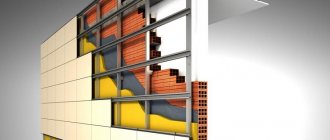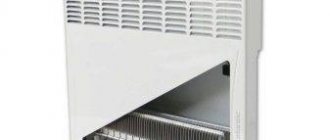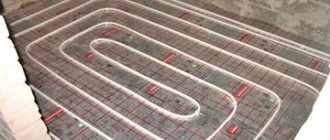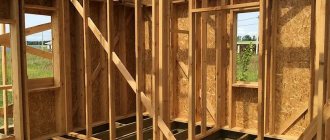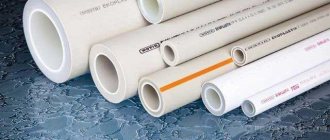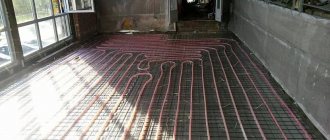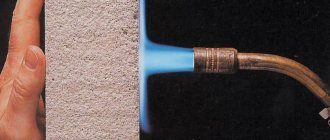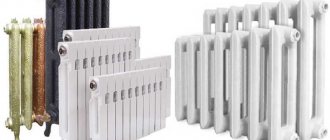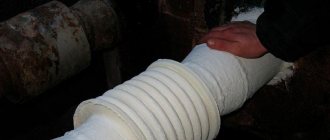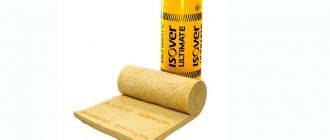In modern life, every family strives to fill their living space with comfort and coziness. Without appropriate heat and sound insulation, such qualities are almost impossible to achieve. That is why the choice of insulating materials should be treated with special attention.
High-quality insulation of all constructed elements is necessary for a comfortable stay. Moreover, this point does not apply only to private houses. Multi-apartment buildings are also often characterized by extraneous irritating sounds from neighbors, as well as the presence of temperatures that are not comfortable for living, which often prompts residents to think about using insulating materials. As for the private sector, the presence of heat and sound insulation is extremely necessary.
Internal noise and thermal insulation of ceilings and walls
Today, due to the great abundance of building materials with insulating properties, it is quite difficult to make the right choice without proper advice from specialists.
Often such advice will require financial expenses from you; in order to avoid such an unpleasant situation, it is advisable to familiarize yourself with the properties of materials that perform heat and sound insulation, as well as familiarize yourself with the options for proper installation. It is the installation work that deserves special attention, since the result, if done improperly, will not give the expected effect.
Styrofoam
Polystyrene foam is a porous and lightweight insulation material. Made from polystyrene by foaming. It is considered one of the best (at low cost) in relation to other thermal insulation materials. It is produced in the form of slabs of different sizes, densities and thicknesses. It has good thermal insulation characteristics, as it consists of tightly connected sealed balls filled with air or gas.
Advantages of foamed polystyrene:
- low thermal conductivity coefficient - 0.035 W/m K;
- ecologically pure;
- does not allow damp air to pass through;
- can last for decades;
- not subject to rotting;
- windproof.
Foam is easy to install by one person, as it is light in weight. It is used both inside the living space - walls, ceiling, floor, and outside. They are used to decorate different surfaces: wood, brick, concrete and others.
It is not used as sound insulation, as it has weak sound insulating properties.
What are Rw and LNW
To assess the ability of various materials and structures to prevent the spread of noise, coefficients are used that show how much the sound level decreases when passing through an obstacle. Taking into account the fact that noise of different types has differences in distribution, it is worth considering two concepts, according to which two evaluation indices are used:
- Sound insulation allows you to determine what part of the sound energy is lost when passing through an obstacle. The amount of loss is expressed by the insulation index Rw. Its value is determined in the sound range in which the main sources of noise are concentrated (100-3000 Hz) and the larger it is, the better the sound insulation system is made.
- Sound absorption shows the loss of sound energy in the barrier itself (due to the rocking of particles, heating), and is used to assess protection against impact noise in the form of the reduced impact noise index LNW. The index shows how much of the sound energy was able to pass through the barrier. Accordingly, this index for good sound insulation systems should be small.
Both indices are measured in decibels and are standardized by law
Extruded polystyrene foam
Externally, extruded polystyrene foam is similar to regular polystyrene foam, but has a higher density and thinner thickness. An extruder is used in its production. Thanks to this, extruded polystyrene foam has closed cells of the same size.
Due to its high density, extrusion is used in the construction of railways and highways, as well as runways. This material has excellent strength, so it can be used not only as thermal insulation, but also as an auxiliary or load-bearing structure.
Positive qualities of extruded polystyrene foam:
- does not absorb liquids;
- does not sit down;
- not afraid of chemicals;
- does not rot and is not overgrown with mold and fungi;
- service life - about 50 years;
- has one of the lowest thermal conductivity coefficients.
It is used for insulation of walls, ceilings, floors, foundations in private houses, apartments and industrial facilities. Just like polystyrene foam, it is used only as thermal insulation.
Polyurethane foam
Consists of two components: polyul and isocyanate. By mixing these substances on special equipment, you can obtain polyurethane foam of different states - from elastic to hard. Polyurethane foam has one of the best thermal conductivity coefficients, so it is used for heat and sound insulation of residential buildings and other objects. The consistency is similar to foam.
Article on the topic: Soundproofing membranes for walls
It can be applied to any structure by spraying. In just a few seconds, a durable and seamless layer of thermal insulation material is obtained. It is important that all application technology rules are followed. Only qualified personnel should work with this thermal insulation using appropriate equipment.
Positive characteristics of polyurethane foam:
- operating temperature - from −150°С to +200°С;
- thermal conductivity coefficient 0.022-0.028 W/m K;
- sprayed onto any surface;
- a durable and monolithic layer is formed;
- has anti-corrosion properties;
- long service life;
- environmentally friendly;
- excellent soundproofing material;
- does not require additional transportation costs, since all components are brought by the service company.
External thermal and noise insulation of walls
The advice of experts is practically the same - you need to choose this type of insulation (if this is the main task), since it is easier to prevent the cold from penetrating the wall of the room than to deal with the consequences of its freezing. There is a certain algorithm of actions that is applicable to thermal and noise insulation outside the house.
Frame for heat and noise insulation
- The walls must first be prepared. The base must be dry, clean and durable. If we are talking about work that requires a frame or sheathing, before constructing it, you need to take care of the vapor barrier so that the materials are not exposed to moisture. This is especially true for working with cotton thermal and noise insulators, since one of the disadvantages of the latter is precisely the fear of moisture. Under its influence, cotton wool loses its properties, and the work will not bring the desired effect. If you want to work with adhesives, the wall must be thoroughly dried. It is not recommended to carry out such external work in the autumn - spring period, when humidity is high, it is better to choose a summer day during a sunny week, then your walls will dry on their own, naturally, without your help.
- Placement of heat and sound insulator. The material should be secured using the method indicated in the technology above - either by gluing (attaching with a stapler) or by placing it under the frame (formwork). It is customary to cover the insulator with special materials for facade work. This could be slabs, siding, or something else.
If you do not have the opportunity to insulate the walls in your apartment from the outside, you can resort to internal installation. We have already presented insulation and soundproofing technologies in this article.
Basalt wool
During the production process, mineral wool is obtained from molten basalt rock processed using a special technology. Additives and binders are also added. Basalt slabs are used for insulation of residential premises and other buildings. They are very convenient for installation, as they are easy to cut with a knife. They can be given any desired shape and installed close to the structure of the house. Basalt slabs are often used as sound insulation on external or internal walls.
It is convenient to insulate inclined surfaces in attic buildings with mineral wool of the required thickness. Basalt wool is well suited as a fire protection device for parts of roofs and roofing in stove-heated houses and bathhouses.
Properties of basalt wool:
- low hygroscopicity;
- high sound insulation ability;
- easy to process;
- has low deformation;
- is a non-flammable material;
- has high thermal insulation qualities.
Cotton materials: glass wool, ecowool, mineral wool
Cotton wool materials are almost identical in characteristics and therefore we will analyze them using mineral wool as an example.
Installation of mineral wool
Mineral wool has:
- Low thermal conductivity.
- Not susceptible to fire.
- Compressive, mechanical and tear strength.
- High soundproofing characteristics.
- Resistant to temperature deformation.
- Biological and chemical resistance.
- Ease and simplicity of installation.
Mineral wool is available in both sheets and rolls and has different thicknesses and softness. The instructions for installing structures using mineral wool are extremely simple:
- It is necessary to close the walls with a steam and hydrobarrier using a stapler, assemble a frame from special metal profiles, adhering to a step of 50 centimeters (cell 50*50).
- Carefully insert mineral wool into the resulting space, making sure that there is no uncovered space.
- Fix in any convenient way.
- Cover the structure with sheets of plasterboard, plastic panels, clapboard, fiberboard.
The base for the walls is ready. You can start finishing; its appearance depends on what material you chose. Before you take on this option, keep in mind that the thickness of the structure will “steal” several tens of centimeters from your room. If sound insulation is the primary reason for repair alterations, then before proceeding with the installation of the structure, inspect the walls, floor, and ceiling for cracks, cracks, and recesses through which extraneous noise can penetrate and seal them. In principle, technology allows you to do everything yourself and not overpay those who do this kind of work, therefore it is not financially expensive.
Cork wall covering
Cork
An environmentally friendly wood material made from oak bark and having a porous structure. All cells are filled with inert gas. It has positive qualities in sound and heat insulation when used in residential premises. Not used outside.
Materials made from technical cork provide excellent sound insulation. It can be divided into three application groups:
- Agglomerate panels are made from crushed cork oak bark, followed by steam treatment and then pressed. Since the bark contains the adhesive substance suberin, unnatural additives are not required. Two types of panels are made: white - from bark taken from tree branches, and black - from stem bark.
- Natural cork - used for decorating rooms. The panels are additionally coated with wax, after which they will not be able to absorb moisture and odors.
- Cork granules are used for insulation of frame buildings.
Article on the topic: Review of Tecsound sound insulation
Technical cork is produced in three forms: sheet, rolled, and in the form of mats.
Roll insulation is most often used as a backing for wallpaper. It comes with or without antibacterial and fireproof impregnation. It is produced in lengths of 10 m and widths from 30 cm to 100 cm. Special glue is used to secure it to the surface of the walls.
Cork in the form of mats and sheets is used to insulate floors, walls and ceilings indoors. Also well suited for sound insulation on the inside of a roof, the covering of which is made of metal tiles or corrugated sheets.
Advantages of cork:
- low thermal conductivity - 0.042 W/m K,
- is resistant to deformation;
- good sound insulation properties - reduces noise by 17 dB;
- excellent antistatic properties;
- environmentally friendly;
- durable;
- natural material.
Working with cork does not require additional physical effort, as it is easily cut to size and convenient to install.
In rooms with high humidity, the cork covering must be protected with waterproofing materials.
Materials used
First of all, when deciding to insulate an apartment or private house, you need to familiarize yourself with the materials that can be used, as well as their properties. It’s worth noting right away that not all materials that act as insulation have good soundproofing properties. Currently, among insulating materials for thermal insulation, there are three types: mineral wool, isolon and cork sheets.
As for polystyrene foam and propylene, they should not be considered here, since these materials cannot boast of soundproofing properties. It also makes no sense to consider various substrates that act as a sound barrier, since they do not have thermal insulation qualities.
Based on this, the choice is either to create a multi-layer structure, or to choose a material that has two sought-after qualities at once. The second option is more preferable, since there will be significantly less possible reduction in space. Each of the material options with heat and sound insulation properties must be considered separately.
Cotton insulating materials
Almost all options for cotton wool products have similar qualities and properties, so there is little point in considering stone wool, glass wool and slag wool separately.
First of all, it is worth highlighting the qualities and advantages of mineral wool:
- products have low thermal conductivity;
- mineral wool fibers are not subject to fire;
- the material has good shape retention qualities. It is resistant to mechanical damage, rupture, and compression;
- mineral wool has excellent sound insulation qualities;
- Such products are characterized by ease of installation work;
- products are resistant to biological as well as chemical influences;
- In addition, the material does not deform in any way due to temperature changes.
The products are produced in two types: in the form of rolled mineral wool, and also in the form of finished layers. Depending on the requirements, the material may vary in thickness.
Next, it is worth considering some recommendations for installing such a product for an apartment or private house:
- First of all, steam or waterproofing material is not sewn onto the surface of the wall. Next, you will need to prepare a frame made of wood or metal. To provide high-quality heat and sound insulation, it is desirable that the frame cells do not extend beyond the dimensions of 50 centimeters by 50 centimeters.
- After the frame is ready, the mineral wool is cut into pieces slightly larger than the cells. It is very important that the insulating material is packed tightly.
- Fixing the insulating layer is possible using any method convenient for you.
- Next, the insulating layer must be covered with facing material.
After this, we can say that thermal and sound insulation has been completed. Then you can freely proceed to further finishing. It is worth considering that the construction of such an insulating layer will steal 10 centimeters from the usable space, so you should first think about this nuance.
With this method of insulating an apartment or private house, there should not be any significant difficulties. All of the above work can be done independently, without special knowledge and skills.
Cotton material
Using isolon
This material has amazing qualities of thermal insulation, as well as protecting the room from extraneous noise. Don't underestimate it because of its subtlety. One layer of isolon is in no way inferior in quality to mineral wool with a layer thickness of five centimeters. The material also perfectly protects the surface from steam, fungus and moisture. At the same time, isolon does not absorb moisture.
The following advantages from using such an insulating material stand out:
- The material is characterized by a closed-cell structure, this moment allows you to regulate the heat transfer of the surface where the isolon is mounted.
- If you use the product as a backing for flooring, the impact resistance of the material is also highlighted.
- Isolon is distinguished by its light weight and flexible structure.
- The material is resistant to open fire.
- Along with the mentioned qualities, it is worth noting that isolon is characterized by its low cost. This moment significantly increases the demand for this material.
- Isolon is also easy to install and dismantle if necessary, without leaving any traces behind.
Might be interesting
Thermal insulation
Insulating the ceiling in a bathhouse - methods, materials, useful...
Thermal insulation
Tables of comparative characteristics of thermal insulation…
Thermal insulation
Why polyurethane foam insulation is the best...
Thermal insulation
Self-adhesive thermal insulation: how to choose and apply?
Installation of this material can be carried out either using an adhesive composition or using conventional fasteners. The material can be used both indoors in an apartment or private house, and for external insulation of a building.
Thermal insulating isolon
Using cork
Quite often, heat and sound insulation of erected walls is carried out using cork coverings. Having chosen this material, first of all, you need to know the positive aspects of its use:
- this insulating material has waterproof properties;
- cork coverings are also resistant to fire;
- the material is not adversely affected by deformation and other pressure;
- the final product has hypoallergenic properties;
- fungus or mold does not form on the surface of such coatings;
- the material is not subject to contamination, and dust does not settle on its surface;
- The finished insulating coating perfectly retains extraneous sharp sounds and also has excellent thermal insulation properties.
Along with a large list of advantages from its use, there are also minor disadvantages, namely:
- the rather high cost of finished products, which not everyone can afford;
- marks from mechanical stress often remain on the material;
- The protective layer of cork coating has low durability.
These disadvantages do not stand out so much in comparison with the large list of advantages. The product is distinguished by a large list of possible types in which cork coverings are made:
- Wallpaper made from cork chips. Here, their installation will require some skills.
- Technical cork covering, which is made individually for other types of finishing materials.
- Tiles made from cork chips are perfect for covering the floor, as well as walls in the bathroom and kitchen.
- Liquid cork coating. This type of insulating material is not particularly popular as a product for renovation work.
- Rolled cork insulation coverings.
It is not so difficult to carry out high-quality installation of cork covering, provided that you are ready for painstaking work. Otherwise, it is better to entrust it to specialists. It is worth noting that when installing the coating, it is not allowed to simultaneously use materials that contain gypsum.
Cork flooring in the hall
Manufacturers of heat and sound insulation panels
On the market of heat and sound insulating materials, cork insulation is represented by the Portuguese company Amorim Group.
The most popular brands of basalt wool are:
- TechnoNikol;
- Paroc;
- Isover;
- Linerock;
- Rockwool.
Well-known trade brands of expanded polystyrene are Penoplex, URSA and TechnoNikol. Of the foam manufacturers, the Knauf brand is the most popular.
Installation of mineral wool on walls
The procedure for soundproofing walls with basalt wool:
- A frame is made of wooden beams on the wall. The distance between the vertical posts is 2 cm less than the width of the insulation.
- Basalt wool slabs are laid.
- Planks are attached to the wooden frame in a horizontal position - for installing gypsum boards.
- Plasterboard sheets are installed. Screwed with self-tapping screws to horizontal crossbars.
Expanded polystyrene boards are installed in a different way - they are attached to the walls or ceiling using glue and special plastic dowels.
Features of thermal insulation in an apartment and tips for choosing
Only environmentally friendly thermal insulation materials should be used in houses and apartments. Cheap basalt wool will contain dangerous phenol-formaldehydes. When the insulation heats up, they begin to turn into volatile compounds that are harmful to human health.
Expanded polystyrene insulation is best used for insulating floors (filled with screed), balconies, loggias, as it is highly flammable. When burning, polystyrene foam emits toxic smoke, causing poisoning. Also, foamed polystyrene does not allow moisture to pass through, so the microclimate in houses or apartments with poor ventilation will worsen.
Soundproofing an apartment using various materials
All people need a cozy rest after a hard day at work, but often noisy neighbors do not allow a person to rest properly. Therefore, any apartment needs high-quality sound insulation. At the same time, you need to know how to soundproof your apartment from neighbors and protect yourself from stress.
How does sound insulation work?
Sound insulation works in two directions:
- Soundproofing. Sounds entering the apartment are reflected, so living in it is calm and comfortable.
- Sound absorption. All sounds coming from your apartment are suppressed, so you will not disturb other residents of the house to relax and work.
Types of noise
Noise is divided into three types:
- Air. It spreads in the air, for example, during people talking.
- Shock. It is formed as a result of the work of construction equipment (perforators, pile drivers, etc.). This is the most unpleasant type of sound, and it is heard at a great distance from the sound source.
- Structural . This noise is caused by vibration. For example, it is published by industrial equipment.
Structural and impact types of noise cause the most problems. Residential premises have great demands on the quality of sound insulation, because they must be well protected from all types of noise. A lot of noise at home and at work always causes fatigue and irritation in a person, and with prolonged exposure it can cause serious nervous diseases in people. Therefore, complete soundproofing of a room or apartment will help protect people from noise and illness.
Permissible noise standards
Current noise standards for residential premises:
- During the day (from 7 am to 11 pm) the noise level should not be higher than 55 dB.
- At night (between 11 p.m. and 7 a.m.) the noise level should not be higher than 45 dB.
The source of noise can be external or internal.
In the first case, noise sources can be: various types of transport (road, rail, etc.), enterprises, construction sites, etc.
Sources of internal noise are: ventilation systems, elevators, water pipes and other life support systems used in residential buildings.
Sources of noise can also be shops, workshops, offices, etc. located on the lower floors of buildings.
If the source of the noise is known, then you need to figure out how to make soundproofing in the apartment with your own hands.
